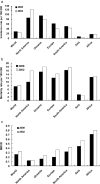Prostate cancer: an emerging threat to the health of aging men in Asia
- PMID: 21552284
- PMCID: PMC3739604
- DOI: 10.1038/aja.2010.126
Prostate cancer: an emerging threat to the health of aging men in Asia
Abstract
The aim of this study was to determine and examine the possible reasons for the difference in prostate cancer incidence between Asian men and North American men by literature review. Data regarding cancer incidence and mortality were obtained from the database of the International Agency for Research on Cancer (IARC). A literature review was conducted by studying related articles published in peer-reviewed journals such as the The New England Journal of Medicine, Journal of Clinical Oncology, A Cancer Journal for Clinicians and Asian Journal of Andrology. To evaluate the early diagnosis and survival rates, the mortality-to-incidence rate ratio (MR/IR) was calculated from the IARC data. By comparing prostate cancer data between Asian men and North American men, we found that differences in the incidence rate and MR/IR could be attributed largely to a lack of annual prostate cancer screening with serum prostate-specific antigen (PSA) in most Asian countries. It is likely that PSA screening also contributes significantly to the differences in prostate cancer mortality rates. Prostate cancer has the highest incidence rate among five common malignancies in Asian Americans. However, the MR/IR ratio of prostate cancer is the lowest among cancers. These data seem to further support the usefulness of PSA screening, even though the percentage of low risk cancers is greater in prostate cancer than in other cancers. The low incidence rate of prostate cancer does not reflect the actual statistics of this disease in Asia. The data from limited institutions in many Asian countries seem to bias the true incidence and mortality rates. To improve this situation, incorporating PSA screening for prostate cancer, as well as constructing a nationwide cancer registration system, will be helpful.
Figures
Similar articles
-
Diagnostic strategies and the incidence of prostate cancer: reasons for the low reported incidence of prostate cancer in China.Asian J Androl. 2009 Jan;11(1):9-13. doi: 10.1038/aja.2008.21. Epub 2008 Dec 1. Asian J Androl. 2009. PMID: 19050685 Free PMC article. Review.
-
Comparison of prostate-specific antigen and hormone levels among men in Singapore and the United States.Cancer Epidemiol Biomarkers Prev. 2005 Jul;14(7):1692-6. doi: 10.1158/1055-9965.EPI-04-0864. Cancer Epidemiol Biomarkers Prev. 2005. PMID: 16030103
-
Prostate specific antigen levels in young adulthood predict prostate cancer risk: results from a cohort of Black and White Americans.J Urol. 2005 Sep;174(3):872-6; discussion 876. doi: 10.1097/01.ju.0000169262.18000.8a. J Urol. 2005. PMID: 16093978
-
Prostate cancer in Asian men.Nat Rev Urol. 2014 Apr;11(4):197-212. doi: 10.1038/nrurol.2014.42. Epub 2014 Mar 4. Nat Rev Urol. 2014. PMID: 24595118 Review.
-
Prostate-specific antigen-based population screening for prostate cancer: current status in Japan and future perspective in Asia.Asian J Androl. 2015 May-Jun;17(3):475-80. doi: 10.4103/1008-682X.143756. Asian J Androl. 2015. PMID: 25578935 Free PMC article. Review.
Cited by
-
Differential Expression and Prognostic Value of Cytoplasmic and Nuclear Cyclin D1 in Prostate Cancer.Biomed Res Int. 2020 May 30;2020:1692658. doi: 10.1155/2020/1692658. eCollection 2020. Biomed Res Int. 2020. PMID: 32566661 Free PMC article.
-
The risks, degree of malignancy and clinical progression of prostate cancer associated with the MDM2 T309G polymorphism: a meta-analysis.Asian J Androl. 2012 Sep;14(5):726-31. doi: 10.1038/aja.2012.65. Epub 2012 Aug 20. Asian J Androl. 2012. PMID: 22902907 Free PMC article.
-
Global Trends and Prostate Cancer: A Review of Incidence, Detection, and Mortality as Influenced by Race, Ethnicity, and Geographic Location.Am J Mens Health. 2018 Nov;12(6):1807-1823. doi: 10.1177/1557988318798279. Epub 2018 Sep 11. Am J Mens Health. 2018. PMID: 30203706 Free PMC article. Review.
-
Overexpression of transglutaminase 4 and prostate cancer progression: a potential predictor of less favourable outcomes.Asian J Androl. 2013 Nov;15(6):742-6. doi: 10.1038/aja.2013.79. Epub 2013 Aug 26. Asian J Androl. 2013. PMID: 23974364 Free PMC article.
-
Prostate cancer detection rate and Gleason score in relation to prostate volume as assessed by magnetic resonance imaging cognitive biopsy and standard biopsy.Turk J Urol. 2020 Nov;46(6):449-454. doi: 10.5152/tud.2020.20248. Epub 2020 Oct 9. Turk J Urol. 2020. PMID: 33052831 Free PMC article.
References
-
- Ries LA, Melbert D, Krapcho M, Stinchcomb DG, Howlader N, et al. SEER Cancer Statistics Review, 1975–2005 Bethesda, MD; National Cancer Institute; http://seer.cancer.gov/csr/1975_2005/, based on November 2007 SEER data submission, posted to the SEER website, 2008.
-
- Ferlay J, Bray F, Pisani P, Parkin DM.GLOBOCAN 2002: Cancer Incidence, Mortality and Prevalence Worldwide. IARC Cancer-Base No. 5, version 2.0 Lyon; IARC Press; 2004.
-
- Venkateswaran V, Klotz LH. Diet and prostate cancer: mechanisms of action and implications for chemoprevention. Nat Rev Urol. 2010;7:442–53. - PubMed
Publication types
MeSH terms
Substances
LinkOut - more resources
Full Text Sources
Medical
Research Materials
Miscellaneous


